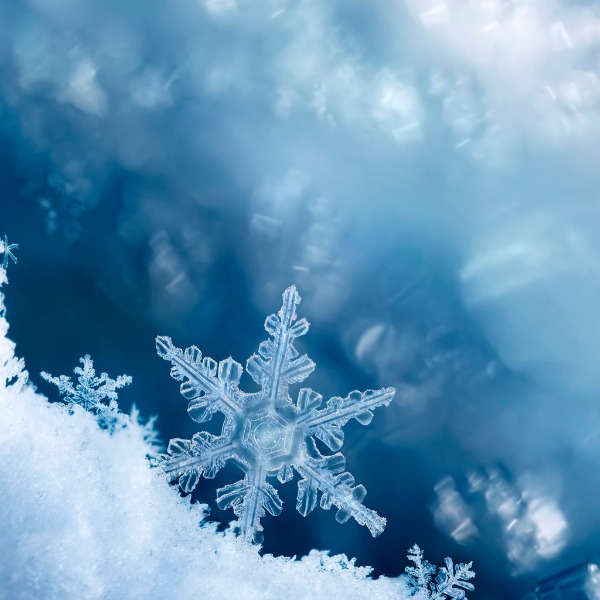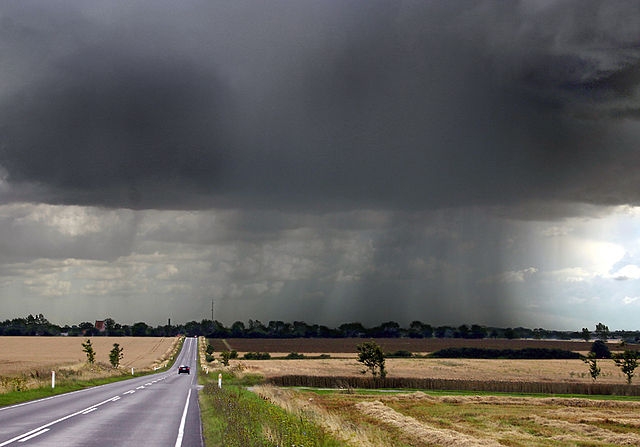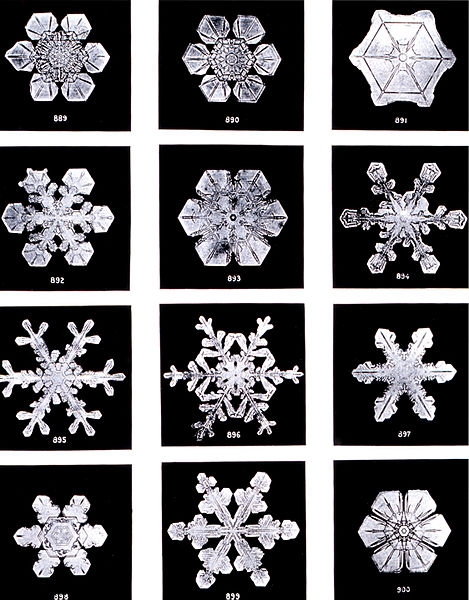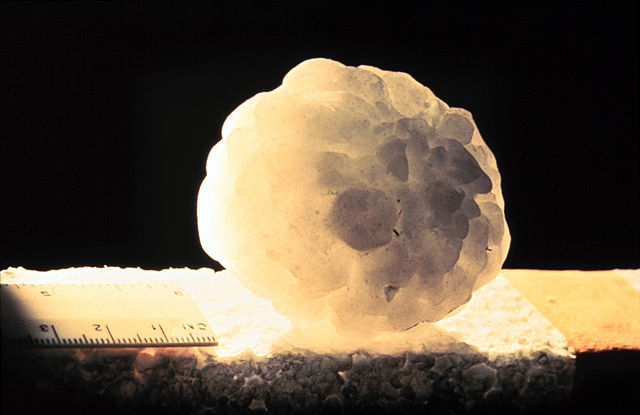Weather: Precipitation

Snowflake (jefunne, iStockphoto)

Snowflake (jefunne, iStockphoto)
How does this align with my curriculum?
Learn about humidity and the many forms of precipitation.
Humidity
Humidity is the amount of water vapour in the air. Dew, frost and that ‘muggy feeling’ on hot days are all signs of water vapour in the air. Humidity is an important part of any habitat. It determines which plants and animals can thrive there.
People are also affected by humidity. When we sweat, the sweat evaporates from our skin. This is what keeps us cool on a hot day. But when it is humid, our sweat evaporates slowly. This is because the air around our bodies is already filled with water vapour. If the humidity is high enough, people can develop heat stroke.
Sometimes people use air conditioners to cool the air inside buildings. But air conditioners also lower the humidity. They have cooling elements that cool the air around them. When water vapour hits these elements, it condenses into liquid water. This removes it from the air.
Microorganisms like bacteria and mould can grow when it’s too humid indoors. Some of these microorganisms can be bad for people’s health. This is why many people use dehumidifiers to remove moisture from the air.
Precipitation
Precipitation is an important part of the Earth’s water cycle. Drizzle, rain, snow, sleet and hail are all different kinds of precipitation. All precipitation starts as water vapour. This condenses into droplets that fall from the sky. Some droplets stay liquid. Other droplets freeze.
Rain
Raindrops start when water vapour condenses on tiny dust particles. Then, these small water droplets bump into each other to form larger droplets. Eventually, they become so heavy that they begin falling to Earth, gathering more water as they go. When the air is unstable, more and more droplets collide, resulting in bigger raindrops. Raindrops can measure from 0.1 mm all the way to 9 mm. That’s a pretty big raindrop!
Freezing rain can happen when the temperature near the ground is close to 0°C, but the air above is warmer. The rain does not have enough time to freeze as it falls, but it turns to ice the instant it lands.
Image - Text Version
Shown is a colour photograph of a dark grey cloud over a rural landscape. Dark clouds cover the top half of the image. Grey, misty streaks stretch from their lower edge, across pale bluish grey sky, to the ground. The landscape is four fields divided by rows of trees and a straight road. The furthest field, under the streaks, is dark brown. The other three are shades of gold.
Snow
Sometimes water droplets in clouds freeze around dust or pollen particles and form ice crystals. One kind of ice crystal is the snow crystal. Snow crystals form when droplets become supercooled. Then they form a six-sided crystal lattice. These snow crystals bump into water droplets in the clouds and grow bigger and bigger. Just like raindrops, when snowflakes get heavy enough, they fall to Earth. They might collide and stick to other snowflakes on the way down. Sometimes, around −2 °C, snowflakes can be 3-dimensional!
You may have heard that no two snowflakes are alike. This is very difficult to prove. Snow crystals form in many different shapes. They are also sensitive to temperature changes. Each one falls from a cloud at a different time, changing shape as it encounters different temperatures along the way. Wilson Alwyn Bentley photographed thousands of snowflakes using a microscope. He didn’t find two identical ones. But his photographs helped scientists understand different snowflake types.
Image - Text Version
Shown are 12 close up, black and white photographs of individual snowflakes The flakes look like gleaming, intricately cut glass. They are mostly white on black backgrounds. Each one looks symmetrical, with six identical, evenly spaced arms radiating out from their centres. Each set of arms has a different shape and thickness, with a different number of smaller branches extending from it. Each photograph has a different three digit number written in white, along the bottom edge.
Did you know?
Scientists think snowflakes can be sorted into eight general categories, 39 intermediate categories, and as many as 121 elementary categories! That means there are up to 10158 possible shapes!
Hail and Sleet
Image - Text Version
Shown is a colour photograph of a large hailstone next to a ruler. The hailstone is roughly spherical and made of many smaller, roughly spherical lumps melded together. It is lit from behind, so its texture is visible, and it glows a warm white. It sits on a rough cement surface in front of a black background. A white ruler stretches from the left edge of the image, to just beside the lump. From this reference, the lump appears to be about 5 cm in diameter.
Hail is when when ice crystals fall to the Earth on warm days. Warm air rises inside clouds. It pushes water droplets up into the colder air above the clouds. This happens over and over again. During this time, the ice crystals collide with more water droplets and grow. These ice chunks, or hailstones, drop to Earth once they are heavy enough to fall through the warm air. Hailstones are larger than 5 mm across. And there have been hailstones the size of golf balls and baseballs!
Did you know?
The largest hailstone ever measured was between 18.8 cm and 23.6 cm in diameter!
Ice pellets are also called sleet. They are small, almost see-through, balls of ice. They are usually smaller than hail. Sometimes you can see ice pellets bounce when they hit the ground. And they don’t usually freeze into a solid layer of ice.
Ice pellets form when there is a layer of warm air between two layers of cold air. Snowflakes form in the cold top layer. They melt a bit as they fall through the warmer layer. Then they freeze again when they pass through the lower layer and hit the ground.
Learn More
Why Does Humidity Make It Feel Hotter? (2017) This video (3:10 min.) from SciShow explains the relationship between heat, humidity, the weather forecast and that sweaty, sticky feeling.
Air Conditioners: Coolest Idea Ever (2016) This video (4:47 min) by SciShow explains why air conditioners were invented, how they work, and how they have changed.
What Do Raindrops Really Look Like? (2018) This video (6:53 min.) from Be Smart shows how indoor skydiving can help us understand the true shapes of raindrops.
How Hail Is Made in Storms (2021) This short video (0:47 min.) from NCAR & UCAR Science Education illustrates how hailstones form, and how they can grow so big!
The Science of Snowflakes (2014) This video (6:00 min.) from Be Smart talks about the millions of ways snowflakes can form, and the history of snowflake research.
References
Bradač, M. (2015). The science of snowflakes.
Cenedese, C., Mason, B. and others. (2020, March 21) Climate - Types of precipitation. Encyclopedia Britannica.
Libbrecht, K., (n.d.) Snowflakes - No Two Alike? Snowcrystals.com
National Oceanic and Atmospheric Administration. Freezing Rain and Sleet. Weather.gov
Rutledge, K., Ramroop, T. et al. (2011, January 21) Hail. National Geographic
United States Geological Survey. The Fundamentals of the Water Cycle.
YouTube. National Geographic.(2011). Humidity.


